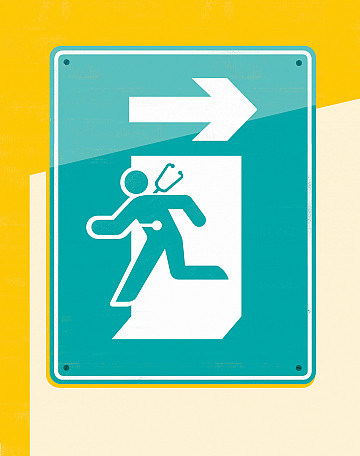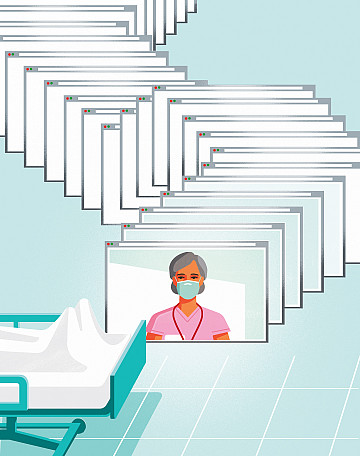As Eeshika Dadheech settled in for her first class with Associate Professor of Nursing Julie Sochalski last spring, her attention was drawn to a quote displayed at the front.
“… it is not surprising that the nursing shortage has received much attention. What is surprising is that despite this concern, the problem appears to have grown steadily worse.”
It was January 2023—New York City nurses were striking over short staffing and working conditions. So Dadheech, Nu’24, W’24 assumed the quote was from a recent news article about those picket lines.
Then, Sochalski, PhD, RN, FAAN, revealed the source: an article published in… 1966.
“Do the math,” Sochalski told them. “We’ve been talking about this for 60 years. Actually, longer.” Then she challenged, “Why aren’t we fixing it?”
The question was a fitting one for the senior capstone course of the Nursing and HealthCare Management program. Dadheech and her fellow students could apply what they had learned in Nursing and Wharton classes to a health care challenge that is persistent and urgent all at once.The U.S. Bureau of Labor Statistics estimates there will be nearly 200,000 openings for registered nurses annually in the next decade—all at a time when increasingly complex patient care requires more professionals with experience. And though RNs were exiting prior to COVID-19, a 2022 survey revealed that at least 100,000 left the workforce during the pandemic. Some retired, but others cited stress and burnout. Of the respondents, 188,962 RNs younger than 40 admitted they weren’t planning to stick around much longer.
Given the potential impact of these losses on everything from patient mortality to the length of hospital stays, the turnover is drawing attention. Last year, U.S. Surgeon General Vivek Murthy issued an advisory that warned about the effect on “the public’s ability to get routine preventive and emergency care, and our country’s ability to respond to public health emergencies.”
There are many reasons a nurse might leave a position. But Sochalski’s students concluded that a big reason the shortage has not been effectively addressed yet is a lack of focus on pressing systemic issues.
Matthew McHugh, PhD, JD, MPH, RN, CRNP, FAAN, GNu’98, GRN’04, Director of the Center for Health Outcomes & Policy Research (CHOPR), agrees. “There are plenty of trained nurses. What we really have is a recruitment and retention problem that has resulted in a shortage of nursing care at the bedside,” says McHugh. He adds, “Many times, people come away feeling like they couldn’t cut it as nurses. But almost invariably it’s something outside of the individual. It’s a systems or an organizational problem. It’s a policy problem.”
With this in mind, many Penn Nursing faculty, students, and alumni, along with the School’s practice partners, are determined to better align cause and response. They are researching technological innovations that would improve working conditions and mitigate burnout. And they are advocating for data-driven policy solutions that ensure equitable access to quality nursing care across the U.S.
Healthy Workplace, Healthy Workforce
“The number one reason that nurses say they leave an institution, or they go find work in a different setting, is because of inadequate staffing and resources,” says McHugh.
His findings are from a 2021 survey of physicians and nurses at 60 hospitals, led by McHugh and fellow CHOPR researchers and published in JAMA Health Forum in July 2023.
He ticks off several other factors driving nurses away from patient care: Safety concerns, lack of management support, limited opportunities for career advancement, and scheduling flexibility.
Among nurses responding to the survey, 47 percent said “administration does not listen or respond to clinician concerns,” and 36 percent said they lacked sufficient control over their workload. The majority also said that just being able to take breaks uninterrupted would be a big relief. So while staffing levels are key—hiring more nurses isn’t the cure alone.
“We have research that shows that the benefits of good staffing can be undermined if they are deployed in a lousy work environment. That even translates in terms of patient mortality,” McHugh says. “You have to focus on these other aspects of the work environment, including management having nurses’ backs, listening to nurses, making sure that there’s a good collegial environment. Those are bread and butter management things that don’t cost a lot of money. It requires a will and taking some action, but that’s a lot cheaper than hiring.”
After all, churn is costly. A national nurse recruiting agency estimated recently that decreasing RN turnover by just one percent saves the average hospital $380,600 per year. Plus, when experienced nurses leave, their valuable institutional knowledge disappears with them.
Health system leaders are taking note, according to Gretchen Berlin, RN, Nu’06, W’06. She works with health care industry clients on designing effective frontline-workforce strategies at consulting firm McKinsey & Company, and says hiring and retention is their “number one through number six priority.” Though awareness was growing before the COVID pandemic, she says she has observed an increase in willingness to make “financial investments to support real retention and staffing stability and flexibility.”
From her CEO seat, Regina Cunningham, RN, AOCN, FAAN, GRN’03, says the Hospital of the University of Pennsylvania (HUP) is focusing on “basics—like transparency, clear messaging from the leadership” and ensuring nurses “have a say in controlling what the work environment really is.”
As efforts to increase diversity continue, health systems also need to be intentional in their recruitment and retention of nurses of color. Research by Tyson Family Endowed Term Chair for Gerontological Research Associate Professor of Nursing J. Margo Brooks Carthon, RN, FAAN, GRN’08, has found Black nurses in community settings are more likely to report job dissatisfaction and intent to leave. And she points to multiple sources that call attention to nurses of color reporting racism and discrimination. “As we talk about work environments, we have to ensure that the policies and the practices are anti-racist in nature,” says Carthon.
In addition, well-intentioned organizational efforts around diversity, equity, and inclusion often mean extra, emotionally exhausting—and typically unpaid—work for nurses of color. Carthon suggests compensating nurses for these efforts. She says nurses also report that mentors and allies can be helpful in making nurses who are contributing to DEI efforts feel valued.
She underscores that improving workplaces—regarding scheduling, career growth, new technology, and so on—must be an all-in effort.
“Organizations don’t just need to fix things for nurses. Nurses need to be involved in the innovative processes, to co-develop solutions. And that’s how you get buy-in and that’s how you ensure that you hit the mark,” Carthon says.
Shaping Policy
For decades, Penn Nursing faculty and alumni have advocated for evidence-based health care policy. Today, many are speaking out about how states can enact laws and regulations that make nursing more sustainable for the long term. They are also advocating for scope of practice expansion to address the inequities of the shortage, which is unevenly distributed across the United States.
“Looking at regulatory barriers is really important as a way to potentially retain—but also better position nurses to work expansively in the places that need them most.”
“When it comes to nurses and nurse practitioners, looking at regulatory barriers is really important as a way to potentially retain—but also better position nurses to work expansively in the places that need them most,” Carthon says. “We can’t afford to constrain them after they’ve been trained, particularly when we have so many communities that just don’t have access to high-quality nursing care.”
Take Pennsylvania, for example, where School faculty have advocated for allowing nurse practitioners full practice authority. A 2022 study estimated that such a policy move by the state could increase the number of NPs in Pennsylvania by 29.5 percent.
State laws on abortion and gender-affirming care are influencing nurses’ career decisions, too.
Some nurses—fearing they will be thrown in jail for prescribing miscarriage medications—may move out of states with restricted abortion access. This could leave communities that already don’t have enough nurses with an even greater shortage. Bloomberg Law reported that, according to one Louisiana public health official, “hospital administrators have also expressed their concerns about staffing shortages, particularly among nurses and other staff, who may refuse to participate in treating certain patients out of fear that they, too, could be criminalized for the treatment decisions of physicians and others.”
Louisiana made most abortions illegal in the state in 2022.
Women’s health nurse practitioner Kelly Nichols, APRN, Nu’15, GNu’17, lives in Philadelphia but commutes to work at a Planned Parenthood clinic in Delaware. The state recently started permitting advanced practice clinicians to prescribe medications for abortion. As the policy change was being considered, Nichols spoke before Delaware officials at a hearing. Today, she says, “I really wouldn’t want to move to a state where I wasn’t allowed to provide this care.”

“We were the only students in the room,” Dadheech says. “It was the first time we had taken our research out of the class. It was great to see them questioning us because they were actually listening to us.”
The students’ solutions include establishing a state funded national health care workforce commission to collect information that, in turn, will inform sound policy. They also proposed developing a standard for capturing the value of nursing care, and a reporting system for hospitals to make nurse staffing levels public.
“It was the coolest way to end my undergraduate career,” Chin Chin Choi, Nu’23, W’23, says of the presentation to Gov. Shapiro’s staff. “The course was a chance to put my Nursing and Wharton sides together to brainstorm and think about solutions that have a real-world impact. Then being able to present it to people in government, and hopefully action can come out of it? It feels great.”
Another alum bringing a nursing perspective to government is Tarik Khan, PhD, CRNP, FNP-BC, GRN’22. A Pennsylvania state house representative, he spoke before that body passed legislation on June 28 to require health systems to staff units according to specific nurse-to-patient ratios. Nodding to CHOPR’s research, he says, “We know that if this bill is implemented, it will save, a conservative estimate is 100 lives a month in Pennsylvania alone. And it will save hospitals $100 million a year in length of stay.” A state Senate vote is pending, and only two other states have passed similar staffing laws (California and, just this year, Oregon). But according to McHugh, such legislation carries the potential to remedy inequities.
“It’s not randomly distributed—which hospitals need this intervention and which ones don’t. It’s usually the hospitals that are serving the poorest populations, historically marginalized populations, rural populations,” he says. “The patient populations who need to benefit from it the most because they’re suffering from the lack of adequate nursing care when they go into their local hospital.”
Innovation at the Bedside
New technologies can also support bedside nursing as a sustainable career, and faculty and alumni are leading innovation on that front. Many are collaborating at the School’s practice partner hospitals where, says Colleen Mattioni, DNP, MBA, RN, CNOR, HUP Chief Nursing Executive, supporting nursing careers is a top priority. “How do we continue to retain this expertise at the bedside, so that it not only reduces stress and burnout, but also increases wellness on the unit? We need to be transferring that knowledge into our novice nurses, for our patient outcomes,” she says.

They are trialing remote nurses to handle patient admissions and discharges, and to provide clinical care support to new nurses working on the floor. The effort is also a chance for nurses to practice remotely—a potentially attractive alternative to have in the mix of a typical work week.
“Maybe two and three decades ago, 12-hour shifts were the way to go. Everyone wanted three 12s,” Trotta says. “Now people want to be able to work in smaller chunks or work at home. We want to be able to provide that level of flexibility.”
At the Children’s Hospital of Philadelphia (CHOP), Professor of Informatics and Clinician-Educator at Penn Nursing Kenrick, Cato, PhD, RN, CPHIMS, FAAN, is setting up an assessment of alarm fatigue that will allow the hospital to formulate an evidence-based plan to reduce the recognized stressor of constant alerts sounding off from equipment.
Together with Sarah Collins Rossetti, PhD, RN, FACMI, FAMIA, Nu’03, an associate professor at Columbia University, Cato is tackling another well-known driver of burnout: documentation burden. According to the CHOPR/LDI survey, 57 percent of nurses said “time spent on electronic health records is moderately high to excessive” and more than half said reducing time spent on documentation would mitigate burnout.
Their “25x5” initiative is so called because it aims, in the next five years, to reduce documentation burden for clinicians to 25 percent of what it is right now. This year, they released a toolkit that offers institutions practical advice for easing documentation burden. Their End Burden study is seizing an opportunity created by the COVID pandemic. During its height, many institutions went into “disaster” mode and reduced note-taking requirements to what nurses felt was absolutely necessary. By combing through records, they’ll look at “what did nurses think was important to document?” Cato says. Initial analyses are expected in late 2023—and the findings could give health care leaders information to act on.
Cato believes large language models (LLM)—think ChatGPT—can also reduce documentation burden in the future. An LLM could scan a transcript of a patient-provider conversation and speedily customize reports for each necessary audience, from quality and regulatory departments to clinicians and patients.
“You are a changemaker. You are a problem solver. You are a future leader. We want you to go in knowing that you have voice and engagement.”
Over at McKinsey, Berlin believes health systems are just “scratching the surface” on using more powerful analytics for scheduling and preventing turnover.
“I think, especially in the inpatient setting, too often it’s, ‘this is what we scheduled six weeks ago, so we’re going to do it again.’ And we have much more sophisticated information on what demand is actually likely to look like, to be able to more dynamically staff that. So we need to lean into that,” Berlin says. Managers might set up a system to flag when any nurse is frequently scheduled in a way that might make them unhappy. “To at least have a conversation and recognize it can go a long way,” she says.
Berlin and her colleagues recently broke down a typical nursing shift into 69 activities. They estimated that up to 20 percent of a 12-hour shift could be “optimized through tech enablement.” Examples include ambient listening, where sensors “listen in” on provider-patient conversations to support documentation, and smart beds that help with patient turning.
Innovation does require investment—and, as Trotta points out, organizations must engage nurses upfront before introducing such changes. When it comes to implementing technology, McHugh cautions that to truly alleviate burnout, innovation needs to support nurses and not create additional task burdens. But, again, that’s where Penn Nursing’s leadership can positively influence the profession and health care in general.
At CHOPR, he says, they scrutinize potential solutions without bias: “None of us really care about the how, as long as it solves the problem. Things that often sound like really good ideas on paper fail in practice. Our role as researchers is to bring accountability and say, here’s the data.”
That’s how Trotta is using her training and research experience in the HUP virtual nursing pilot. She says part of her role on the trial team is ”to ensure that we’re able to collect the right data to demonstrate the outcomes that we hypothesize it will drive.”
Turning Around Turnover
Implementing effective innovation and laws have something in common: They take time. But when it comes to addressing the urgent matter of nurse retention, glimmers of hope can be found.
Nearly all hospital-based physicians and nurses responding to the CHOPR/LDI survey reported positive professional relations and efficient teamwork. “These findings,” the researchers wrote, “hold promise for clinicians acting together to bring about important changes in their work environments.”
And while organizations need to own systemic change, each nurse—whether at the bedside or behind a research desk—can also make a difference.

“I think everybody is concerned about burnout with clinicians and everyone also wants the evidence to support policymaking,” Cato says. He says that national funders are realizing the need to support research into issues like documentation burden and burnout. “That evidence is going to take three to five-plus years to generate, but you have to start,” he says.
Increasing advocacy from frontline nurses can also positively influence health system leaders and policymakers. “They’re empowered by their own experiences and they’re supported by the evidence,” Carthon says. “I absolutely think that we can continue to make strides and progress.”
Carthon also points optimistically to the School’s role in educating tomorrow’s nurses who will positively influence their workplaces—and help ensure that 60 years from now, students won’t be spending a semester puzzling over why we haven’t addressed the nursing shortage.
“We want our students to feel like you don’t have to go into an environment and say, ‘well, that’s just the way it is.’ You are a changemaker. You are a problem solver. You are a future leader,” she says. “We want you to go in knowing that you have voice and engagement. Part of being a Penn Nurse is bringing that into the institution with you.”
Back to Fall 2023 Issue










